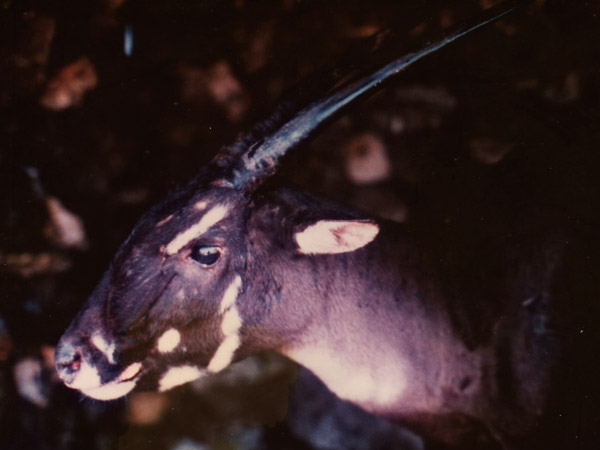This is the second of a series of two articles examining Western Nghe An Biosphere Reserve, the impetus behind its creation, and the efficacy of its protections. Part 1 can be found here.
Encompassing 1.3 million hectares, Western Nghe An Biosphere Reserve the largest such reserve in all of Southeast Asia. It straddles the border between northern Vietnam and Laos, and is home to many unique and threatened species. Because of the biological importance of the region, it was designated a biosphere reserve by UNESCO in 2007. But deforestation and bushmeat hunting continue, begging the question: is the wildlife of Western Nghe An Biosphere Reserve truly protected?
Within Western Nghe An Reserve lives a large mammal at very high risk of extinction – the saola (Pseudoryx nghetinhensis), also called “Asia’s unicorn,” which was unknown to science until its discovery in 1992. Endemic to the Annamite Mountains of Laos and Vietnam, the saola still remains one of the rarest and least sighted large mammals in the wild. Its population status remains unknown, and despite being so rare, it has received little conservation attention and funding.

A female saola that was brought into a Laos village in 1996 nicknamed Martha. She died after only 18 days in captivity. Photo by William Robichaud.
According to data from Global Forest Watch, Vietnam lost more than one million hectares of forest from 2001 to 2013, representing about 7 percent of the country’s total forest cover. During the same time span, Western Nghe An Biosphere Reserve lost about 3 percent of its forest cover. While this is an improvement over Vietnam as a whole, the rate of forest loss in the area did not change significantly after its induction as a biosphere reserve, with more than 25,000 hectares lost between 2007 and 2013.
Hunting is also a big problem in the reserve. It is this that poses the greatest threat to the saola.
“By the time deforestation or fragmentation is likely to be a threat (we think), the saola will already be long gone,” said Nicholas Wilkinson, a graduate student at University of Cambridge, who works on the conservation of saola in Vietnam. “It would be like… I don’t know… worrying about the effects of climate change in Syria – potentially very serious in future but just not the current area of concern.”

Western Nghe An Biosphere Reserve contains 1.3 million hectares, and encompasses other protected areas. Still, the region lost 3 percent of its forest cover from 2001 to 2013, and about one-third of its areas of intact forest have been degraded since 2000. Click to enlarge.

During the period from 2001 through 2012, there has been an upward trend in forest loss in Vietnam, peaking in 2010. Graph made using data from Global Forest Watch.
William Robichaud, Coordinator of the Saola Working Group, agreed that controlling hunting was the way to go for now. “Snares need to be removed and gun hunting needs to be reduced in key saola sites to save the species from going extinct in the near-term, while working on long-term attitudinal changes,” he said.
According to Cao Tien Trung who works for the work for Center for Environment and Rural Development at the Vinh University and is a member of the Saola Working Group, current management regulations are not very effective for the conservation of wildlife. Trung advocates for community-based conservation.
 Martha lived only a few days in captivity. Photo by William Robichaud. |
“The relationship between local communities surrounding the NR and forest resources should be recognized as it has existed for a long time – men have long been involved in hunting and women in collecting other forest products,” he said.
Trung added that conservation in Vietnam is largely dependent on international funding and partnerships with international NGOs. And this is a matter of concern.
“While this brings in powerful ideas as well as money, it leads to an unstable situation and is one of the causes of widespread conservation failure in the country,” he said. “Domestic environmental NGOs are restricted in their field of operation and have a largely urban base. Community-based organizations, we believe, are crucial to the future of conservation in Vietnam but require long-term support and stable relationships with their supporters, something which international projects cannot easily provide.”
Verdict?
The biosphere reserve model of UNESCO’s Man and the Biosphere Reserve Program does emphasize conservation efforts that are people-centric. However, in many cases and particularly in developing countries like Vietnam, this conservation model often remains only on paper. While representing international recognition, a biosphere reserve falls under the jurisdiction of individual member countries. These regions often do not have the legislation, logistics or resources to ensure that goals of the biosphere reserve model are met.
In a paper published last year in Biological Reviews, researchers reviewing the effectiveness of biosphere reserves across the world wrote, “For the Biosphere Reserve model to be successful long term, it requires political buy-in at the level of state/provincial or national government, and if popular political benefit is seen to be absent, it is unlikely that these governments will continue to support the ideals of the Biosphere Reserve concept.”

Close-up of WWF camera trap photo of saola taken in September 2013. Photo by WWF.
}}
Related articles

(09/30/2014) In 2010, poachers shot and killed the last Javan rhino in Vietnam, wiping out an entire subspecies. The Sumatran rhino, the Malayan tapir and the civet otter, too, have disappeared from the country. Moreover, charismatic species like tigers, elephants, gibbons and the secretive saola discovered recently in Vietnam’s forests are at risk of extinction in the coming decades as threats to wildlife continue unabated in the country.
Studying common birds could help save rare species in Vietnam
(09/30/2014) Studies in conservation biology often focus on rare, threatened species faced with impending extinction, but what about common animals of least concern? Could they too help conservationists fine-tune their approach? Doctoral researcher Laurel Yohe not only claims that they can, but demonstrates how in a new study. She and five other researchers compared ranges of five babblers with development across Vietnam.
NASA: Forest loss leaps in Bolivia, Mekong region
(08/08/2014) New satellite data from NASA suggests that deforestation is sharply increasing in Bolivia and Mekong countries during the second quarter of 2014.
Downturn in shade-grown coffee putting forests, wildlife, people at risk

(07/11/2014) Growing coffee in the shade of forests allows native vegetation to persist, thereby reducing the impact of agriculture on the natural landscape. While production of shade-grown coffee surged in recent decades, it is now experiencing a decline. A recent study analyzed the situation, finding that the growth of consumer demand and changes in coffee agronomy has caused coffee production and management to change drastically.
Logging in Vietnam still affecting rare trees 30 years later

(06/25/2014) Restricted geographic ranges, high habitat specificity, and small local population sizes all contribute to the natural rarity of many tree species. Anthropogenic activities such as selective logging can compound this rarity by modifying habitats and altering the competitive balance among tree species. According to a new study, previous logging in the forests of Vietnam continue to put rare tree species at risk.
Tropical nations make progress in slowing deforestation
(06/10/2014) Efforts to slow destruction of tropical forests seem to be paying off in a number of countries, argues a new report published by the Union of Concerned Scientists (UCS).
Chinese luxury furniture linked to murder, near extinction

(05/12/2014) Intricately carved, meticulously designed, and costing hundreds of thousands of dollars: this is “hongmu,” or Chinese luxury furniture reflecting the elite styles of the Ming and Qing dynasties. But while the red-colored furniture may be aesthetically beautiful, it comes with a blood price.
Game of thorns: colorful, spiky tree frog discovered in Vietnam

(04/25/2014) Evening fog settled quickly on Mount Ngoc Linh, as the steady drone of cicadas and crickets took up their usual nighttime chorus. The night calm was broken by sudden crashing through the thick bamboo stands and excited voices. High in this isolated cloud forest in central Vietnam, researchers had come upon the first thorny tree frog known to science.
Long lost mammal photographed on camera trap in Vietnam

(03/25/2014) In 1929, two sons of Theodore Roosevelt (Teddy Junior and Kermit) led an expedition that killed a barking deer, or muntjac, in present-day Laos, which has left scientists puzzled for over 80 years. At first scientists believed it to be a distinct species of muntjac and named it Roosevelts’ muntjac (Muntiacus rooseveltorum), however that designation was soon cast into doubt with some scientists claiming it was a specimen of an already-known muntjac or a subspecies. The problem was compounded by the fact that the animal simply disappeared in the wild. No one ever documented a living Roosevelts’ muntjac again—until now.